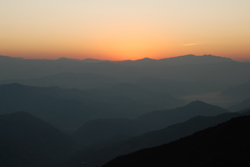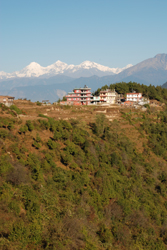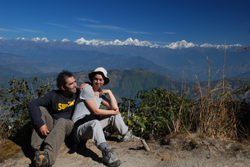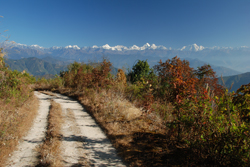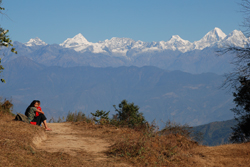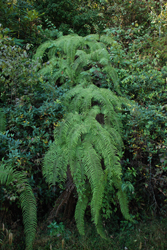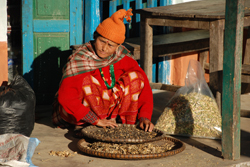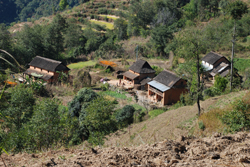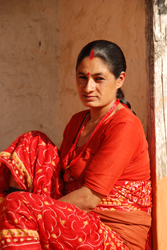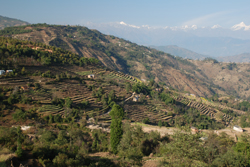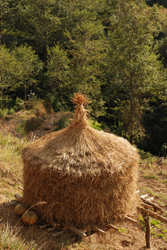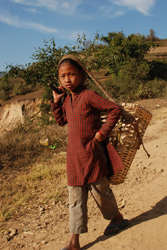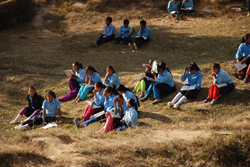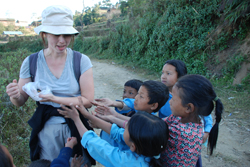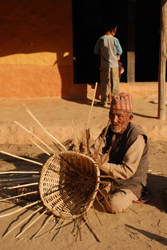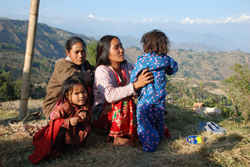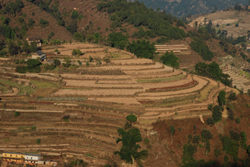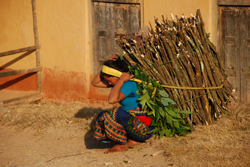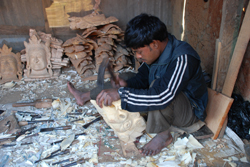Nagarkot Trek Day 2: To Nagarkot: DO NOT FEED THE CHILDREN
30 November, 2008, 12:23 am in "Nepal"
Even after their prank attempt of the previous night, the girls still managed to get up about ˝ hour before us and fill the hall with voices and footsteps. We got up at 6 and emerged into a hall filled with boys and girls walking back and forth brushing their teeth.
The clouds that had covered them mountains at dusk the night before had disappeared leaving the mountains shining like a diamond necklace in the sky. The sun hadn't risen yet but was filling the Eastern sky with shades of rose and gold.
One of the amazing things about the Himalayas is how they just seem to stretch on and on forever, mountain range after snow crowned mountain range. From Chisopani, the snow capped peaks seemed to run off into the the East until they faded into blue shadows, mountains obscured by distance and smog. To the West, they disappeared obscured by some trees only to reappear on the other side once again disappearing from view behind some closer hills. Even from our height of 2000 meters, the mountains seem to float above us in the sky. The hills below were obscured by smog hiding the mountains connection with the earth. The valley dropped below us with terraced hillsides like a living contour map.
We had to wait for the sun to rise a bit from behind the mountains in the East before the pink light touched the tops of the rest of the mountains and gradually crept over the snow covered peaks. Shisher joined us and pointed out the different ranges: Annapurna to the West, then Manaslu (where the village where he grew up is located), and Ganesh Himal.
We had to wait for the sun to rise a bit from behind the mountains in the East before the pink light touched the tops of the rest of the mountains and gradually crept over the snow covered peaks. Shisher joined us and pointed out the different ranges: Annapurna to the West, then Manaslu (where the village where he grew up is located), and Ganesh Himal.
It was a beautiful morning for hiking-- crisp and cool but with a clear blue sky and a warm sun. The path followed the side of a small mountain and most of the time we walked parallel to the Himalayas which soared above the green terraced valleys.
There was a cool dampness in the shade which produced a wealth of green trees and bushes. Light green ferns draped themselves over trees looking like a giant feather boas. As we descended a little into the valley, we left the forest and approached a more settled area.
The atmosphere became more cheerful with cultivated patches of flowers adding more color and cows, buffalo, goats and chickens adding their voices and movements to the scene. Women in bright colored clothing washed more bright colored clothes by a stream or did other chores. The houses were adorned with bunches of corn hanging to dry from the eves and balconies. The terraced fields were neat and organized compared to the chaotic greens of the forest.
We stopped in the village of Chauki Bhanjyang for lunch at a restaurant owned by someone who originally came from the same town as Shisher. The village was at the crossroads of a foot path and the road. There was a hotel and a couple shops. Chickens, dogs and goats wandered the streets. Occasionally a truck would roll by sending a cloud of dust up. In front of one of the hotels, someone played a guitar.
We had dal bhat which, though similar to the dal bhat of the night before, had a different curry containing greens and potatoes as well as a different mix of lentils (dal). Dal bhat is the quintessential Nepali food. It is literally translated as “lentils and rice”. Usually it includes a huge pile of rice, a bowl of lentil soup, potato curry, and a “papad” (like a giant spiced tortilla chip). Sometimes it contains some greens as well. Though eating it would seem to be redundant, many places prepare it slightly differently so you can get away with eating it quite frequently.
From there we walked along the road through other villages with haystacks looking like beach bungalows on a tropical island. There were clusters of bamboo and banana trees. We walked through a village called Jahar Sinpauwa. There was a school in session outside and teenagers in school uniforms sat reading in the sun. It seems whenever we pass a school building there is a mess of noise emanating from it. However, out in the open air, everyone seemed to be peacefully concentrating on their studies.
We had dal bhat which, though similar to the dal bhat of the night before, had a different curry containing greens and potatoes as well as a different mix of lentils (dal). Dal bhat is the quintessential Nepali food. It is literally translated as “lentils and rice”. Usually it includes a huge pile of rice, a bowl of lentil soup, potato curry, and a “papad” (like a giant spiced tortilla chip). Sometimes it contains some greens as well. Though eating it would seem to be redundant, many places prepare it slightly differently so you can get away with eating it quite frequently.
From there we walked along the road through other villages with haystacks looking like beach bungalows on a tropical island. There were clusters of bamboo and banana trees. We walked through a village called Jahar Sinpauwa. There was a school in session outside and teenagers in school uniforms sat reading in the sun. It seems whenever we pass a school building there is a mess of noise emanating from it. However, out in the open air, everyone seemed to be peacefully concentrating on their studies.
Further on, Rowshan stopped to take some photos of a group of kids who excitedly demanded a photo. After giggling over the photo they started demanding, “Chockla Chockla!” (“candy” a bastardization of “chocolate”) Rowshan called me over and asked me to get out our nuts and raisins from our bag. Now, one is not supposed to give children treats because it teaches them to beg, and I know this. However, I stupidly pulled out the plastic bag and opened it, half expecting them to run off in disgust seeing it didn't contain candy. However, at the sight of the open bag, the kids crowded around me with dirty hands grabbing. One girl grabbed two handfulls before I realized I needed to do the distribution myself. It felt like a scene from a horror film where I was about to be torn apart by miniature zombies who instead of crying, “Brains! BRAINS!” cried, “Chockla! Chockla!”
We managed to escape their clutches but they pursued Rowshan quite a ways down the road crying, “CHOCKLA! CHOCKLA!” Begging is a huge problem in Nepal. The entry card we filled out to get our visa even requests, “Do not encourage begging by being benevolent.” Children everywhere request candy, money, and pens. They may not know any other English except, “Hello. Give me pen (money, rupee, chockla)” Lonely Planet and other “responsible travel” organizations request that travelers refrain from giving things to children because it encourages them to beg. The pen begging is an interesting example of this. I remember, when I first started traveling on my own, reading the advice of giving children pens, notebooks and school materials instead of candy. That was perhaps 15 years ago and I have had the opportunity to see how this piece of advice went horribly wrong. The current PC thing to do is donate to organizations instead.
Back on the road, we passed a basket weaver and many people who thankfully just went along doing their daily business. As we walked into Nagarkot we saw a man carving wooden masks. Nagarkot is on the top of a hill covered with pine trees. Its a resort town with tons of hotels but more importantly a fabulous view of the Himalayas and the valley.
Back on the road, we passed a basket weaver and many people who thankfully just went along doing their daily business. As we walked into Nagarkot we saw a man carving wooden masks. Nagarkot is on the top of a hill covered with pine trees. Its a resort town with tons of hotels but more importantly a fabulous view of the Himalayas and the valley.
Comments
- Comments
Powered by My Blog 1.69. Copyright 2003-2006 FuzzyMonkey.net.
Created by the scripting wizards at FuzzyMonkey.net..
(Code modified by Rowshan Dowlatabadi)
Created by the scripting wizards at FuzzyMonkey.net..
(Code modified by Rowshan Dowlatabadi)



